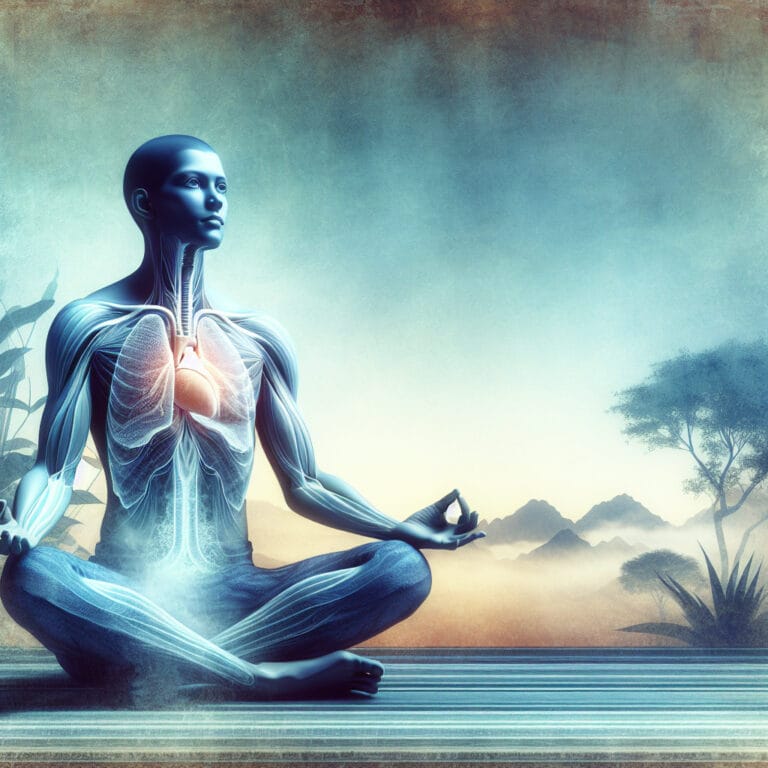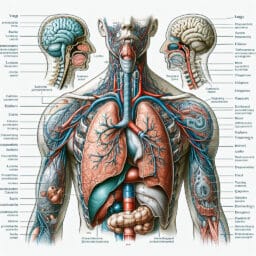
Understanding the Impact of Stress on Breathing Patterns and Strategies for Correction
Table of Contents
- Introduction to Stress and Its Effects on Breathing
- The Science Behind Stress-Induced Breathing Patterns
- Common Stress-Related Breathing Disorders
- Techniques to Correct Stress-Induced Breathing Patterns
- Integrating Breathing Correction into Daily Life
- Conclusion
- Frequently Asked Questions
Introduction to Stress and Its Effects on Breathing
The intricate dance between our nervous system and breathing patterns is never more apparent than during moments of stress, where each deep breath can become a powerful ally in the quest for tranquility. When stress invades our lives, it triggers a cascade within the body – heart rate accelerates, muscles tense, and our stress response kicks into overdrive. Yet with each purposeful inhale, as the abdomen expands gently, we beckon the parasympathetic nervous system to usher in calmness. It’s here that diaphragmatic breathing becomes not just a technique but an elixir for mental health; by practicing breathing exercises such as coherent breathing or pursed-lips respiration, we can encourage a relaxation response that effectively counters day-to-day stressors.
Deep breathing exercises are pivotal in stress management strategies. As we engage in these practices regularly—inhaling slowly to fill the lungs entirely before holding the breath momentarily then exhaling with equal deliberateness—the body learns to modulate its reaction to anxiety-provoking situations. This act alone can reduce stress significantly and restore equilibrium to both mind and body. Breath retention works subtly yet powerfully; by pausing after an inhale or before an exhale, one promotes heightened oxygenation and bolsters resilience against life’s pressures.
For those lowering stress through meditating or other mindfulness practices, integrating controlled breathing patterns can amplify benefits. The gentle rhythm of taking deep breaths sets a pace conducive to introspection and focus—foundational elements of successful meditation sessions. Those who commit to practice breathing exercises frequently discover that they possess a readily accessible tool for defusing tension almost instantly.
In essence, adopting regulated breathing methods serves as preventive healthcare—a means of inoculating oneself against the inevitable adversities life presents while enhancing overall well-being. Whether it’s seeking refuge from workplace demands or navigating personal challenges, mastery over one’s own respiration pattern emerges as both shield and sword in the battle against overwhelming anxiety. Thus equipped with knowledge and practice of these techniques, anyone may tap into their inherent potential for self-regulation and peace amidst chaos—an empowerment all should aspire to achieve.
The Science Behind Stress-Induced Breathing Patterns
As the tendrils of stress wrap tightly around our daily lives, the intimate connection between our mental health and respiratory patterns becomes glaringly apparent. The autonomic nervous system, a silent conductor orchestrating the symphony of bodily functions, often responds to stress by triggering an ancient survival mechanism—the fight-or-flight response. During such episodes, heart rate surges, muscles brace for action, and breathing becomes shallow and rapid. This biological alarm system is designed for short-term survival; however, when activated frequently by day-to-day stressors, it can lead to a chronic imbalance in breathing patterns that undermines our well-being.
What many don’t realize is that diaphragmatic breathing—or deep abdominal breathing—can coax the parasympathetic nervous system into initiating a relaxation response. By encouraging full expansion of the abdomen with each deep breath taken and allowing for slow breath retention before exhalation, we guide ourselves into a state of serenity amidst life’s tumultuous seas. Coherent breathing practices tether us to a rhythmical pattern that not only reduces stress but also stabilizes heart rate and blood pressure.
Incorporating pursed-lips breathing exercises into one’s self-care regimen unlocks further benefits; this technique extends exhalations ensuring more complete release of air from the lungs—an act which has been shown to engender immediate relief from acute stress responses. Committing to practice these exercises regularly creates an internal sanctuary where one can retreat during moments overwhelmed by anxiety or pressure.
For those integrating lowering stress meditating techniques with deliberate respiratory methods like coherent or diaphragmatic breathing routines find that their capacity to manage stressful stimuli expands significantly. They learn how oxygen-rich deep breaths envelop them in calmness akin to an emotional reset button being pressed—a physiological shift transpiring as they exhale slowly and deliberately.
Embracing these strategies not only equips individuals with tools essential for effective stress management but also emboldens them with autonomy over their own nervous system responses. By mastering control over one’s personal respiration rhythm through dedicated practice of varied deep-breathing exercises—from measured inhales and prolonged pauses to unhurried exhales—the potential exists not simply for reducing transient tension but fostering long-term tranquility in both body and mind.
| Concept | Description | Benefits | Techniques |
|---|---|---|---|
| Autonomic Nervous System | Responds to stress with the fight-or-flight response, increasing heart rate and producing shallow, rapid breathing. | N/A | N/A |
| Diaphragmatic Breathing | Deep abdominal breathing that promotes full abdominal expansion and slow exhalation. | Initiates relaxation response, reduces stress, stabilizes heart rate and blood pressure. | Full abdomen expansion, slow breath retention, controlled exhalation. |
| Coherent Breathing | Rhythmical breathing pattern that reduces stress and stabilizes physiological functions. | Reduces stress, stabilizes heart rate and blood pressure. | Measured inhales, prolonged pauses, unhurried exhales. |
| Pursed-Lips Breathing | A technique that extends exhalations and ensures more complete release of air from the lungs. | Provides immediate relief from acute stress responses. | Extended exhalations, more complete air release. |
| Meditative Breathing | Combines stress-lowering meditative techniques with deliberate respiratory methods. | Expands capacity to manage stress, emotional reset, fosters tranquility. | Deep breaths, combining meditation with breathing exercises. |
| Long-term Practice | Regular practice of deep-breathing exercises to gain control over personal respiration rhythm. | Reduces long-term stress, fosters tranquility in body and mind. | Consistent practice of varied deep-breathing exercises. |
Techniques to Correct Stress-Induced Breathing Patterns
In the labyrinth of modern life, where day-to-day stressors are as certain as the ticking clock, our mental health and heart rate are often held hostage by the whims of our nervous system. Amidst this turmoil, diaphragmatic breathing emerges as a beacon of relief, guiding us to harness the parasympathetic nervous system and evoke a relaxation response that acts as an antidote to stress. Here lies an untapped reservoir of serenity—deep breaths can serve both as shields against life’s onslaughts and keys to unlock profound tranquility.
Mindfulness and meditation practices have been lauded for their ability to improve respiratory control. By fostering awareness on each inhalation and exhalation, these techniques place you in command of your breathing pattern—transforming erratic breaths into coherent breathing sequences that soothe the psyche. As one’s abdomen expands with a deep breath in mindfulness meditation, so does their capacity for calmness in response to external pressures.
Guidance through diaphragmatic breathing exercises is like being handed a map through uncharted territory—the journey from high-stress levels to peace becomes navigable. The process begins with positioning: one hand on the chest, another on the belly; then embarks with inhaling deeply through the nose until you feel your abdomen rise more than your chest—a sign that your lungs are filling properly. Retaining this breath momentarily before exhaling slowly through pursed lips allows for complete oxygen exchange—a fundamental step towards achieving balance within.
A pioneering method in managing anxiety-induced respiratory irregularities is biofeedback therapy. This form of treatment equips individuals with real-time data about physiological functions such as muscle tension and heartbeat, thereby enabling them to consciously adjust their stress response. Biofeedback has been shown to be particularly effective when combined with regular practice breathing exercises; it provides measurable outcomes that bolster confidence in one’s ability to modulate stress reactions.
Alongside these practices stands progressive muscle relaxation (PMR), an unsung hero among stress management techniques focused not just on the act of respiration but also on bodily tension release. PMR involves systematically tensing then relaxing different muscle groups throughout the body—an act which complements deep breathing exercises by encouraging holistic relaxation. The result? A symphony where every inhale brings vigor and every exhale carries away fatigue.
One must not underestimate how significant achieving mastery over one’s own physiology can be—breath retention coupled with slow exhales wields power enough not only to reduce immediate symptoms but also foster long-term resilience against chronic anxiety patterns caused by relentless stimuli bombarding our senses daily.
As we continue weaving narratives around stress management strategies that include lowering stress meditating approaches or delving into nuanced yoga pranayama tactics—it becomes evident that integrating controlled deep breaths into our lives can recalibrate our internal environment back towards equilibrium.
Framing all these facets within daily routines establishes an invisible barrier against mounting pressures while ensuring each new challenge is met not with frantic disarray but poised readiness—an artful convergence where disciplined respiration meets mental fortitude.
Integrating Breathing Correction into Daily Life
Amid the whirlwind of day-to-day stressors, the sanctity of our mental health often hinges on the rhythmic tides of our breathing patterns—a truth that underscores the profound interplay between our nervous system and respiratory functions. By fostering a daily breathing routine, individuals can recalibrate their nervous system to favor the parasympathetic response over its sympathetic counterpart, ushering in a relaxation response that lowers heart rate and shields against stress. Deep breathing exercises such as diaphragmatic breathing—that ritualistic expansion of the abdomen with each deep breath followed by controlled breath retention—are not mere ephemeral remedies but cornerstones for enduring stress management.
Harnessing coherent breathing techniques is akin to conducting an internal orchestra where every inhale cues serenity and each exhale slowly dissipates tension. This intricate synchronization does more than reduce stress momentarily; it fortifies mental well-being over time, allowing one to navigate turbulent waters with resilience and composure. Even simple practices like pursed lips breathing can significantly impact physiological responses during acute stress episodes, providing a readily accessible tool for immediate relief.
Integrating these exercises into one’s lifestyle calls for regularity—carving out moments each day to practice breathing exercises ensures that this equilibrium becomes second nature rather than a fleeting refuge amidst chaos. The daily commitment to lowering stress through meditating or dedicated practice sessions cultivates an environment where one’s default state leans towards calmness rather than agitation.
The long-term benefits are manifold: from heightened alertness and improved concentration to decreased susceptibility to anxiety-triggered ailments—a testament to how vital correct breathing pattern maintenance truly is for overall well-being. Individuals committed to nurturing their respiratory practices report transformative experiences; what begins as an endeavor in reducing physiological markers like heart rate evolves into holistic self-care impacting all aspects of life.
As we peel back layers revealing just how intrinsic a role our respiratory system plays in combating day-to-day pressures, mastering one’s own respiration rhythm surfaces as both preventive medicine and psychological panacea—each deep breath taken becomes a steppingstone toward unwavering tranquility amidst life’s symphony of stresses.
Conclusion
Amid the relentless pace of modern living, the often-overlooked cadence of our breathing patterns plays a pivotal role in mitigating the effects of stress on our mental health. Deep diaphragmatic breathing—a deliberate expansion of the abdomen with each inhale—activates the parasympathetic nervous system, triggering a relaxation response that can lower heart rate and diffuse stress. This physiological shift underscores a powerful connection between mindful respiration and emotional well-being. By incorporating coherent breathing exercises into daily routines, individuals can recalibrate their stress response, fostering resilience against day-to-day stressors. The practice of pursed-lips techniques or breath retention further refines one’s ability to exhale slowly and regulate their breathing pattern, enhancing overall stress management efficacy. As these practices become ingrained through repetition, they not only reduce immediate anxiety but also contribute to long-term tranquility and stability within the nervous system—an invaluable asset for anyone navigating today’s high-pressure environments.



